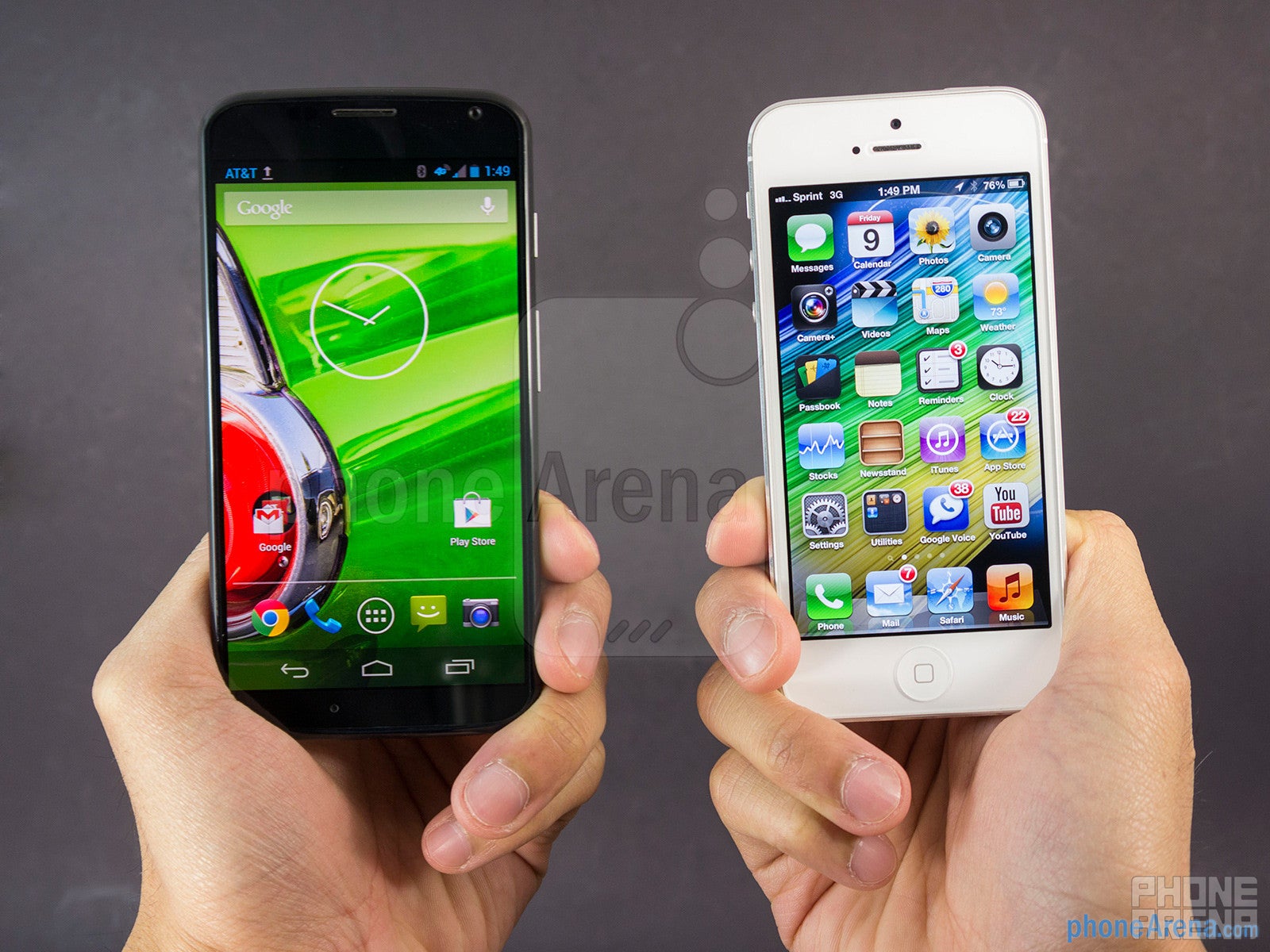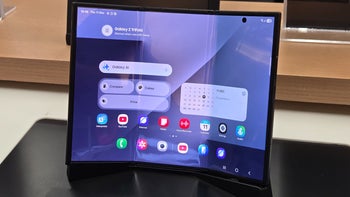Motorola Moto X vs Apple iPhone 5

Introduction:
After being dormant for the last couple of years, Motorola has just opened the floodgates to its upcoming flagship smartphone in the Moto X – a device that’s remarkably fashioned to tangle with the greats. Naturally, the iPhone 5 is something that this new found smartphone intends on competing against, since they stack up so similarly to one another. Apple’s prodigy might be seeing its last days, but nevertheless, it’s still widely regarded as the flagship device to beat in the landscape.
Design:
As always, the iPhone 5 has the premium element to its design, thus, it exudes the sturdier construction between the two. However, we’re quick to realize that the Moto X simply has the more comfortable and natural feel in the hand, as its curved rear casing is contoured perfectly to fit our palm. Indeed, its composite body with its soft touch coating might not be as premium, but heck, the customizable aspect with the Moto X’s design process is something noteworthy on its own, seeing that no other smartphone on the market can match the depth of personalization that Moto Maker offers prospective customers.
Display:
From a specs sheet standpoint, the iPhone 5’s 4-inch 640 x 1135 Retina Display has the slight advantage with pixel density, but it’s hardly noticeable over the Moto X’s larger 4.7-inch 720 x 1280 AMOLED display. Taking a gander at our web site from a zoomed out view in their respective browsers, our eyes are able to distinguish details very easily with the two – with neither one actually edging the other. That’s essentially where their similarities end, as the IPS-LCD based panel of the iPhone 5 produces the more accurate and natural colors, whereas it’s more saturated with the AMOLED panel of the Moto X. When it comes to outdoor visibility, the iPhone 5’s panel is noticeably brighter, which offers us better clarity.
After being dormant for the last couple of years, Motorola has just opened the floodgates to its upcoming flagship smartphone in the Moto X – a device that’s remarkably fashioned to tangle with the greats. Naturally, the iPhone 5 is something that this new found smartphone intends on competing against, since they stack up so similarly to one another. Apple’s prodigy might be seeing its last days, but nevertheless, it’s still widely regarded as the flagship device to beat in the landscape.
Design:
As always, the iPhone 5 has the premium element to its design, thus, it exudes the sturdier construction between the two. However, we’re quick to realize that the Moto X simply has the more comfortable and natural feel in the hand, as its curved rear casing is contoured perfectly to fit our palm. Indeed, its composite body with its soft touch coating might not be as premium, but heck, the customizable aspect with the Moto X’s design process is something noteworthy on its own, seeing that no other smartphone on the market can match the depth of personalization that Moto Maker offers prospective customers.
Display:
From a specs sheet standpoint, the iPhone 5’s 4-inch 640 x 1135 Retina Display has the slight advantage with pixel density, but it’s hardly noticeable over the Moto X’s larger 4.7-inch 720 x 1280 AMOLED display. Taking a gander at our web site from a zoomed out view in their respective browsers, our eyes are able to distinguish details very easily with the two – with neither one actually edging the other. That’s essentially where their similarities end, as the IPS-LCD based panel of the iPhone 5 produces the more accurate and natural colors, whereas it’s more saturated with the AMOLED panel of the Moto X. When it comes to outdoor visibility, the iPhone 5’s panel is noticeably brighter, which offers us better clarity.
Motorola Moto X 360-Degrees View:
Apple iPhone 5 360-Degrees View:
Interface and Functionality:
Interestingly enough, these two smartphones place a lot of emphasis on simplicity with their respective platform experiences. Android is known for its higher complexity and comprehensive personalization over iOS, but Motorola has done enough to the mostly stock Android 4.2.2 Jelly Bean experience of the Moto X to make it even easier to navigate and operate the handset. As much as we appreciate the static and hassle-free experience of iOS, it’s starting to show its age, seeing that it lacks the set of compelling new features that the Moto X is bringing to the table – like Touchless Controls and Quick Capture Camera. At the moment, iOS continues to have quality third party apps, but the gap is quickly lessening.
We all know that these two platforms have their own personal digital assistant services, Siri with iOS and Google Now with Android, but at this point, there’s no denying which one has the upper hand. When it comes down to it, Google Now has proven its worth in actually learning and becoming self-aware – plus, it helps that Touchless Controls gives us instant access to the service.
It surely has the size advantage with is display, but in actuality, the on-screen keyboard of the Moto X doesn’t prove to be any more spacious than what the iPhone 5 offers. Seeing that, we don’t find one to be particularly better than the other when typing stuff up, as they are both responsive and offer accurate typing.
Processor and Memory:
Breaking the mold, these two flagships perfectly show us why you don’t need cutting-edge hardware specs to produce the best performances – it’ a modified version of the dual-core 1.7GHz Qualcomm Snapdragon S4 Pro processor couple with 2GB of RAM in the Moto X, and a dual-core 1.3GHz Apple A6 CPU with 1GB of RAM in the iPhone 5. Running the same tasks, both exude the same peppy responses that aren’t tested by even complex operations. In fact, it’s very rare that we find either device stalling with their performances. At the end of the day, their mighty real-world performances make us sleep at night knowing that they can still give us top-notch results.
Hardly a surprise in this day and age, they feature closed designs with no expandable memory, which means that we’re required to be more conscious of what we save. With the Moto X, it’s available in 16GB and 32GB capacities – whereas the iPhone 5 is offered in 16GB, 32GB, and 64GB.
Internet and Connectivity:
Yet again, we’re not taken by surprise by their phenomenal web browsing performances, as the two feature lightning fast 4G LTE connectivity and tight navigational controls. Certainly, we find a few more tricks with the Google Chrome Browser on the Moto X that proves to be useful over mobile Safari, but we can’t neglect to mention that Chrome is also available for iOS as well.
World travelers should have no concern with these flagships, since they’re both available in GSM and CDMA flavors. Moreover, they have common connectivity features as well – these include aGPS, Bluetooth 4.0, and dual-band 802.11 a/b/g/n Wi-Fi. However, it’s only the Moto X that benefits in the quick sharing department with NFC on board.
Interestingly enough, these two smartphones place a lot of emphasis on simplicity with their respective platform experiences. Android is known for its higher complexity and comprehensive personalization over iOS, but Motorola has done enough to the mostly stock Android 4.2.2 Jelly Bean experience of the Moto X to make it even easier to navigate and operate the handset. As much as we appreciate the static and hassle-free experience of iOS, it’s starting to show its age, seeing that it lacks the set of compelling new features that the Moto X is bringing to the table – like Touchless Controls and Quick Capture Camera. At the moment, iOS continues to have quality third party apps, but the gap is quickly lessening.
We all know that these two platforms have their own personal digital assistant services, Siri with iOS and Google Now with Android, but at this point, there’s no denying which one has the upper hand. When it comes down to it, Google Now has proven its worth in actually learning and becoming self-aware – plus, it helps that Touchless Controls gives us instant access to the service.
It surely has the size advantage with is display, but in actuality, the on-screen keyboard of the Moto X doesn’t prove to be any more spacious than what the iPhone 5 offers. Seeing that, we don’t find one to be particularly better than the other when typing stuff up, as they are both responsive and offer accurate typing.
Processor and Memory:
Breaking the mold, these two flagships perfectly show us why you don’t need cutting-edge hardware specs to produce the best performances – it’ a modified version of the dual-core 1.7GHz Qualcomm Snapdragon S4 Pro processor couple with 2GB of RAM in the Moto X, and a dual-core 1.3GHz Apple A6 CPU with 1GB of RAM in the iPhone 5. Running the same tasks, both exude the same peppy responses that aren’t tested by even complex operations. In fact, it’s very rare that we find either device stalling with their performances. At the end of the day, their mighty real-world performances make us sleep at night knowing that they can still give us top-notch results.
Hardly a surprise in this day and age, they feature closed designs with no expandable memory, which means that we’re required to be more conscious of what we save. With the Moto X, it’s available in 16GB and 32GB capacities – whereas the iPhone 5 is offered in 16GB, 32GB, and 64GB.
Internet and Connectivity:
Yet again, we’re not taken by surprise by their phenomenal web browsing performances, as the two feature lightning fast 4G LTE connectivity and tight navigational controls. Certainly, we find a few more tricks with the Google Chrome Browser on the Moto X that proves to be useful over mobile Safari, but we can’t neglect to mention that Chrome is also available for iOS as well.
World travelers should have no concern with these flagships, since they’re both available in GSM and CDMA flavors. Moreover, they have common connectivity features as well – these include aGPS, Bluetooth 4.0, and dual-band 802.11 a/b/g/n Wi-Fi. However, it’s only the Moto X that benefits in the quick sharing department with NFC on board.
Camera:
Driving simplicity into the experience, the camera apps on both these devices are very similar to one another. Whereas other smartphones have an eclectic mix of shooting modes and manual controls, these opt for the straightforward approach of being quick, easy, and simple, which is evident by their uncluttered interfaces. Additionally, we love we can get quick access to their camera apps when they’re locked.
Motorola touts the performance of the Moto X’s 10-megapixel “Clear Pixel” camera, but as we look meticulously at its results over the iPhone 5’s 8-megapixel iSight camera, it’s still behind by just a smidgen. Overall, we can’t complain about the qualities from both, as it’s hardly noticeable at first glance which one has the edge, but the iPhone 5’s camera captures a little bit more fine detail. Beyond that, everything else is pretty similar in situations where lighting is ample. Under low lighting, we see the same results too, as the iPhone 5 snags slightly sharper visuals.
At the same time, their 1080p video recording qualities rival one another – with neither one able to outclass the other tremendously. Again, the iPhone 5 churns out details that have a tiny bit more sharpness, but its audio recording has a flatter tone to it. Aside from those two specific things, everything else pretty much are on par to one another.
Motorola Moto X Sample Video

Apple iPhone 5 Sample Video

Multimedia:
We’re not strangers to their music apps, since they’re the same ones we all know and love. Pumping up their volumes to their max, we’ll say that they emit the same commanding tones that don’t strain or distort.
Even though there’s no concern when playing high definition videos, especially when their playbacks are smooth, the Moto X seems to be the more ideal device to stick with for the experience. First, it has more support for various video codecs – whereas the iPhone 5 requires us to convert certain ones to properly load and play. And finally, the larger sized AMOLED panel of the Moto X has stuff to keep us affixed to it more than the iPhone 5’s Retinal Display.
Driving simplicity into the experience, the camera apps on both these devices are very similar to one another. Whereas other smartphones have an eclectic mix of shooting modes and manual controls, these opt for the straightforward approach of being quick, easy, and simple, which is evident by their uncluttered interfaces. Additionally, we love we can get quick access to their camera apps when they’re locked.
Motorola touts the performance of the Moto X’s 10-megapixel “Clear Pixel” camera, but as we look meticulously at its results over the iPhone 5’s 8-megapixel iSight camera, it’s still behind by just a smidgen. Overall, we can’t complain about the qualities from both, as it’s hardly noticeable at first glance which one has the edge, but the iPhone 5’s camera captures a little bit more fine detail. Beyond that, everything else is pretty similar in situations where lighting is ample. Under low lighting, we see the same results too, as the iPhone 5 snags slightly sharper visuals.
At the same time, their 1080p video recording qualities rival one another – with neither one able to outclass the other tremendously. Again, the iPhone 5 churns out details that have a tiny bit more sharpness, but its audio recording has a flatter tone to it. Aside from those two specific things, everything else pretty much are on par to one another.
Motorola Moto X Sample Video

Apple iPhone 5 Sample Video

Multimedia:
We’re not strangers to their music apps, since they’re the same ones we all know and love. Pumping up their volumes to their max, we’ll say that they emit the same commanding tones that don’t strain or distort.
Even though there’s no concern when playing high definition videos, especially when their playbacks are smooth, the Moto X seems to be the more ideal device to stick with for the experience. First, it has more support for various video codecs – whereas the iPhone 5 requires us to convert certain ones to properly load and play. And finally, the larger sized AMOLED panel of the Moto X has stuff to keep us affixed to it more than the iPhone 5’s Retinal Display.
Call Quality:

Battery:
Far from being the class leaders in the space, both the Moto X and iPhone 5 deliver average results with their battery life. Specifically, we’re able to get in a solid one-day of normal usage out of the two. Moreover, for those power users out there, we’re able to get by through an 8-hour work shift with little concern.
Conclusion:
When the dust settles, it’s plainly obvious that these two flagship smartphones perform similarly to one another – with neither one having a dramatic advantage over the other in any particular category. Heck, even their on-contract prices are the same too, as their base configurations start at $200. Ultimately though, it’s the enhancements found with the Moto X’s platform experience that propels it over the iPhone 5. Needless to say, the iPhone 5 continues to be a strong all-around contender in the space, which isn’t all that surprising, but Moto’s offering has its own set of goodies to make it an admirable choice as well. You might say that we’re growing weary with what iOS has to offer. On the other hand, the Moto X is a fresh and exciting entrant to the space – both from a design and software standpoint.

Follow us on Google News











Things that are NOT allowed:
To help keep our community safe and free from spam, we apply temporary limits to newly created accounts: